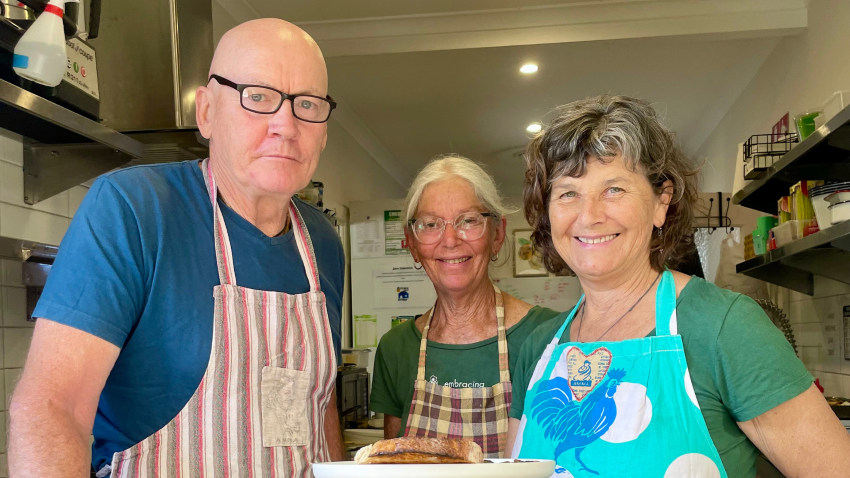By Paul Bibby
The birth of the Byron Community Centre in 1980 was a profoundly important moment in the history of the Shire – an event which shaped our community in ways which continue to be felt today. But few who call Byron home these days know the story of how it all came about.
Last week, The Echo sat down with Jan Dawkins, one of the founding members of this iconic institution, to hear her story and learn about the centre’s origins.
Ms Dawkins recalls that the need for the centre became particularly clear to her on a rainy afternoon in 1979, when her daughter said she was going to the Byron pinball parlour (known as ‘The Rib Cage’).
‘The Rib Cage was okay, but it really wasn’t the best place for a teenage girl to hang out,’ says Ms Dawkins, who lived in Skinners Shoot at the time. ‘There were quite a lot of older kids hanging out there, and some of them were into drugs and drinking.
‘When I said that to her, she said something like “where do you want me to go then? There isn’t anywhere else!”’
‘The reality was that there wasn’t anywhere else for young people to hang out in Byron Bay at that time, and it just seemed obvious to me that they needed somewhere to go that was fun for them but also safe.’ So Ms Dawkins decided to do something about it.
With other concerned locals, including Maggie Waddell, Karen McCarthy, Kitty Harris, and Maureen Craven, Ms Dawkins formed a small group whose goal was the creation of a Youth and Resources Centre. They wrote a short letter to The Byron News publicly declaring their intention and calling for interested locals to join them.
Big response
The response was overwhelming. ‘People started calling straight away,’ Ms Dawkins says. ‘A lot of people came to the first meeting, and by the third meeting, it was packed.’
Many of those who got involved were part of the alternative community – people who had come to the region before, during, or shortly after the 1973 Aquarius Festival and made a life here.
‘We all basically felt that there should be an alternative way of looking at life and of living,’ Ms Dawkins said.
In complete contrast to the stereotypical view of ‘alternatives’ as lazy hippies, Ms Dawkins and her colleagues were extremely proactive and energised. During their first few meetings, the group settled on a venue for the centre – the old Byron Bay Literary Institute on Jonson Street.
The site had already had many names and iterations by 1979, having hosted the Byron School of Arts and the town’s first library back in 1895.
A much bigger two-storey building was completed in 1907, and for many decades this space was the focal point for the town, hosting a range of venues over the years including a dance hall, movie theatre, skating rink and a gym. But by the late 1970s, the building was barely used, and in dire need of repair. As such, it was a perfect site for the community to come together.
‘A few of us joined the board of the Literary Institute and voted for the building to be made available for a range of activities for young people and the wider community,’
Ms Dawkins recalls.

Free events
After returning the space to a functional state, Ms Dawkins and her colleagues wasted no time in organising free events for the community.
‘We had Saturday morning activities for kids, jazz on a Sunday, a leather work class, pottery workshops – people would turn up and say, “I’d like to offer this” and it would go on the big chalk board out the front. People would roll past and see what was happening and then come back and drop their kids off.’
With the help of funding from Byron Council’s parks and reserves committee, the old building was further refurbished and repainted. And as the space changed, so did the services on offer.
The group quickly realised that there was a pressing need for services supporting the homeless, young people at risk, and affordable child-care. Through a largely organic process it became the Byron Community Centre – a hub that continues to provide activities, host events, and is a key provider of social services and education.
The centre was instrumental in setting up a youth homelessness refuge, an adult education school, which became the Byron Community College, and childcare services. ‘We learned such a lot because in those early days none of us really knew how to organise something like this.’
What they did have was a philosophy of inclusion. ‘Anyone who wanted to come along to the centre and say something or share something about what was happening in the community could do that,’ Ms Dawkins says.
In the ensuing years, the Byron Community Centre continued to expand and grow, with a new Byron Community Centre completed in 2003.
‘We really weren’t thinking too far into the future most of the time,’ Ms Dawkins says, ‘we just saw a need there and I think we were just the type of people who dived in and did things.’
This article appeared in The Echo by Paul Bibby in April 2025.




.jpg)

.jpg)